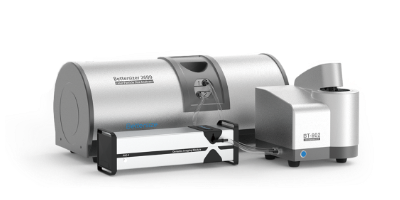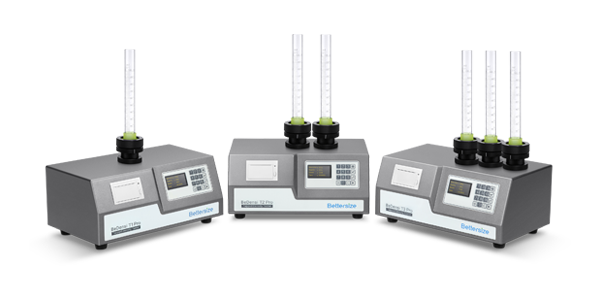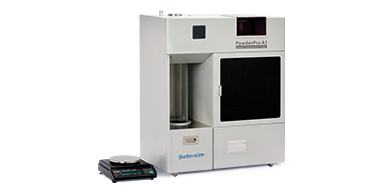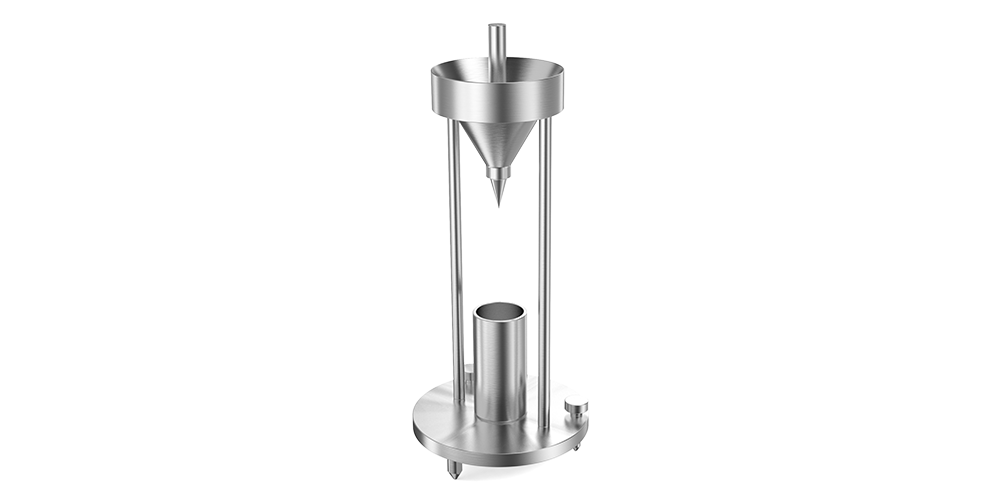Mineração e minerais
Os instrumentos de análise de tamanho e forma de partículas da Bettersize são amplamente utilizados na pesquisa, fabricação e aplicação de todos os tipos de mineração e minerais, trazendo lucros favoráveis.
O analisador de tamanho e forma de partículas e o testador de características de pó da Bettersize podem fornecer análise completa de propriedades físicas e análise de granulometria para o processamento profundo de mineração e minerais, além de oferecer dados que incluem distribuição de tamanho de partículas, forma de partículas, fluidez, densidade de batida e densidade aparente, ajudando a reduzir o custo do processamento de minerais e a controlar os graus corretos de partículas dos produtos.
Abrasivos, fluorita, gálio, mica, carbonato de sódio, antimônio, granada, molibdênio, arsênico, níquel, estrôncio, amianto, germânio, nióbio, enxofre, barita, ouro, talco, bauxita, grafite, tântalo, Berílio, gesso, perlita, telúrio, bismuto, háfnio, rocha fosfática, tálio, boro, platina, tório, bromo, índio, potássio, estanho, cádmio, iodo, pedra-pomes, titânio, cimento, ferro e aço, Cristal de quartzo, tungstênio, césio, minério de ferro, terras raras, vanádio, cromo, pigmentos de óxido de ferro, rênio, vermiculita, argilas, cianita, rubídio, wollastonita, cobalto, chumbo, ítrio, cobre, cal, areia, zeólitas, diamante, lítio, escândio, zinco, diatomita, magnésio, selênio, zircônio, feldspato, manganês e silício são todos materiais que são minerados e depois extraídos do minério. Se for extraído, a medição da distribuição do tamanho das partículas na extração de minerais úteis é um processo árduo e tecnicamente exigente. O minério é detonado ou cortado, carregado e transportado para o moinho para o esmagamento e a moagem secundários, que preparam o material para o uso pretendido.
Cominuição
Em muitos casos, os minerais valiosos estão misturados com ganga e o minério precisa ser separado. A primeira etapa de muitos processos de separação é a cominuição (redução de tamanho), seguida pela classificação (separação por tamanho de partícula), seja para moagem adicional ou para a próxima etapa, a concentração do minério. Durante a cominuição, o minério deve ser moído de forma que as partículas sejam pequenas o suficiente para que cada partícula seja composta principalmente por um mineral. Essas partículas são então separadas para concentrar o produto mineral.
Separação por gravidade
A separação por gravidade se baseia em diferenças na massa do material para separar os minerais. Os métodos incluem jigues, comportas, espirais, mesas vibratórias, separadores de partículas finas, hidrosizadores e ciclones. A separação por gravidade é uma separação baseada apenas no peso e é diretamente afetada pelo tamanho da partícula, pois o volume é proporcional ao peso.
O jigging usa fluxo de água pulsado ou um processo semelhante para empurrar o material moído para cima.
As partículas mais pesadas e maiores afundarão mais rapidamente entre os pulsos e, portanto, tenderão para o fundo do jigue. Portanto, o tamanho uniforme das partículas é importante para garantir a separação por densidade e não por tamanho. Além disso, a operação do jig (duração dos pulsos de água) e o projeto dependerão do tamanho das partículas que estão sendo separadas. As eclusas e espirais dependem da diferença entre a resistência viscosa e a flutuabilidade para a separação das partículas. Essa diferença está diretamente relacionada ao tamanho das partículas. As mesas de gravidade usam uma plataforma vibratória para separar por tamanho de partícula e gravidade específica. Assim, alimentações com distribuição estreita de tamanho resultam em melhor separação.
Flotação de espuma.
Aqui o material é separado pela química da superfície. As bolhas que fluem por uma pasta ou suspensão tendem a aderir às partículas com uma superfície hidrofóbica e fazem com que as partículas flutuem até o topo de uma espuma para recuperação. Muitas vezes, as superfícies das partículas são modificadas seletivamente para que as superfícies minerais sejam hidrofóbicas e as superfícies de ganga sejam hidrofílicas. O tamanho das partículas é importante para a eficiência do processo. Partículas muito finas podem ser arrastadas no fluxo da bolha, independentemente da química da superfície, reduzindo a eficácia da separação. Partículas muito grandes tenderão a afundar, independentemente da fixação da bolha.
Separação eletrostática e magnética
O comportamento de uma partícula sob campos eletrostáticos ou magnéticos pode ser explorado para separar as partículas por tipo. Esses campos induzem cargas (ou magnetismo). As forças resultantes farão com que as partículas se movam, dependendo da massa da partícula. Assim, as partículas pequenas são movidas mais longe do que as partículas grandes. Além disso, a carga da partícula é um fenômeno de superfície e a maior área de superfície das partículas finas tenderá a ter uma carga maior. Esses efeitos de tamanho podem levar à separação por tamanho e não por composição. Dessa forma, uma distribuição estreita de tamanho geralmente, mas nem sempre, leva a uma melhor separação.
Envio do produto
O produto final geralmente é classificado e vendido no estado em que se encontra ou para processamento posterior. Os usuários desejam uma faixa de tamanho de partícula específica para garantir que seu processo seja otimizado. Assim, na importantíssima etapa de venda dos produtos, muitas minas controlam o tamanho das partículas e, em alguns casos, o formato das partículas também é importante.
Os sistemas de dimensionamento de partículas abaixo são totalmente capazes de medir o tamanho e a forma para ajudar o usuário a obter o tamanho ideal em todo o processo de fabricação.
Citations
- Bettersizer 2600
Functional redundancy as an indicator for evaluating functional diversity of macrobenthos under the mussel raft farm near Gouqi Island
DOI: 10.1016/j.aquaculture.2023.740024 Read ArticleZhejiang Ocean University | 2024Biological traits analysis (BTA) helps to evaluate the effects of different environmental variables on the traits-based functional composition of macrobenthos. However, research on functional traits of macrobenthos under mussel farming is limited. We investigated the spatial and temporal response of the benthic system in terms of taxonomic and functional diversity to environmental variables of farming and natural stressors resulting from suspended mussel farming near Gouqi Island of eastern China Sea. The functional traits of macrobenthic assemblages under mussel farming were characterized by “medium adult body size”, “vermiform body form”, “high flexibility”, “infauna”, “semi-motile”, “gonochoristic”, “surface deposit-feeders”, “carnivores”, “semi-motile burrowers”, and “tube-dwellers”. Functional redundancy was stable in response to mussel farming stresses among seasons, whereas species diversity showed efficient to evaluate natural variables. Functional diversity was significantly affected by farming stressors rather than natural variables, Further analysis using multivariate methods together with continuous monitoring were highlighted to evaluate the impacts of mussel farming. Our results reinforce the importance of macrobenthic species and functional traits analysis to evaluate human stresses driven impacts in offshore ecosystems. By analysing the environmental variables with different sources, independently, we concluded the main effects of human pressures on macrobenthic community. Such distinction could be particularly effective to isolate variable environmental descriptors and evaluate their effects on functional diversity, making the current approach promising for the evaluation of ecological effects of anthropogenic stressors in aquaculture areas. - Bettersizer 2600
Degradation characteristics and utilization strategies of a covalent bonded resin-based solid amine during capturing CO2 from flue gas
DOI: 10.1016/j.seppur.2023.125621 Read ArticleChina University of Petroleum | 2024In this study, various types of degradation as well as attrition which are possibly encountered in a circulating fluidized bed temperature swing adsorption (CFB-TSA) process, were conducted experimentally to evaluate the stability of a resin-based solid amine sorbent. Other characterizations methods, such as elemental analysis (EA), Fourier transform infrared spectroscopy (FTIR) etc. were applied to further reveal the degradation mechanisms. The results showed that thermal degradation occurs from 140–160 °C due to the decomposition of amine group. The CO2-induced degradation occurs from a higher temperature of 160–180 °C accompanied by the production of urea. Hydrothermal stability is good below 130 °C, but the ionic impurities in steam crystalized on particle surface can accelerate the degradation. Oxidative degradation is the most harmful, which starts at a lower temperature of 70–80 °C with the formation of aldehyde. The existence of H2O in atmosphere can alleviate the oxidative and CO2-induced degradations. The employed sorbent has a very low attrition index of 0.05, which is 1–2 orders lower than typical commercial fluidized bed catalysts. Based on the results of stability evaluation, some design suggestions for proper utilization of this sorbent or other similar resin-based sorbents have been provided in an industrial CFB-TSA process.
- Bettersizer 2600
De-branching of starch molecules enhanced the complexation with chitosan and its potential utilization for delivering hydrophobic compounds
DOI: 10.1016/j.foodhyd.2023.109498 Read ArticleShihezi University | 2024The current study aimed to prepare the complexes between debranched-waxy corn starch and chitosan polymers (DBS-CS), and then investigated their corresponding structural characteristics, rheological property and potent application in Pickering emulsion. The results indicated that the existence of chitosan significantly inhibited starch short-range molecular rearrangement for all DBS-CS samples, which was manipulated by both debranching treatment and chitosan content. Interestingly, this is the first study to reveal that the outstanding peak at 1.8 ppm in 1H NMR spectrum for sample DBS-CS was gradually shifted towards a lower-field region following an increased chitosan content. Moreover, the debranching treatment shifted the crystallinity pattern from A-type to B-type and the relative crystallinity of DBS-CS decreased gradually with the increased content of CS. All samples had a pseudoplastic fluid and shear-thinning behavior with an enhanced shear resistance following the complexation. The DBS-CS was applied in a Pickering emulsion for showing a greater emulsifying stability and a lower gel strength than native NS-CS prepared emulsion. Importantly, the encapsulation ability of curcumin in the DBS-CS emulsion was significantly improved, followed by an increase of 15.45% for its corresponding bioavailability compared to the control. Therefore, this study might highlight a potential carrier for delivering the bioactive substances in a green pattern. - Bettersizer 2600
Heat-induced aggregation behavior of wheat gluten after adding citrus pectin with different esterification degree
DOI: 10.1016/j.foodhyd.2023.109420 Read ArticleGansu Agricultural University | 2024Wheat gluten aggregation during heat treatment is beneficial to the final quality of gluten-based products. Exogenous pectin can affect gluten aggregation. However, the effect of pectin with different degrees of esterification on the heat-induced aggregation behavior of gluten and its possible mechanism are still unclear. Thus, the heat-induced aggregation behavior of gluten after adding pectin with different esterification degree was studied in this study. When the temperature was raised from 25 °C to 95 °C, pectin affected gluten aggregation and was related to the degree of esterification. Specifically, the results of rheological properties and particle size indicated that low-ester pectin improved the viscoelasticity of gluten and promoted gluten aggregation. Thermal properties revealed that enthalpy of gluten added with low-ester pectin (37%) increased from 92.96 J/g to 95.40 J/g during heating process. Structurally, the fluorescence intensity and surface hydrophobicity of gluten added with low-ester pectin (37%) were lower than those added with high-ester pectin (73%). In addition, low-ester pectin (37%) significantly increased the disulfide bond content (from 15.31 μmol/g to 18.06 μmol/g) and maintained β-sheet content of gluten compared with gluten alone at 95 °C, indicating that low-ester pectin was more likely to induce gluten aggregation. However, scanning electron microscope showed that the gluten added with low-ester pectin (46%) exhibited a denser network structure at 95 °C than that added with low-ester pectin (37%). These results will provide a theoretical base for the regulation of gluten aggregation and the quality of gluten-based products by pectin with different esterification degree.
- 1
- 2
- 3
- 4
- 5
- 6
- 84
Recursos selecionados
Analisador de tamanho de partículas relacionado
-
Bettersizer S3 Plus
Particle Size and Shape Analyzer
Measurement range: 0.01 - 3,500μm (Laser System)
Measurement range: 2 - 3,500μm (Image System)
-
Bettersizer 2600
Laser Diffraction Particle Size Analyzer
Measurement range: 0.02 - 2,600μm (Wet dispersion)
Measurement range: 0.1 - 2,600μm (Dry dispersion)
Measurement range: 2 - 3,500μm (dynamic imaging)
-
BeVision D2
Dynamic Image Analyzer
Dispersion type: Dry
Measurement range: 30 - 10,000μm
Technology: Dynamic Image Analysis
-
BeVision M1
Automated Static Image Analyzer
Dispersion type: Dry
Measurement range: 1 - 10,000μm
Technology: Automated Static Image Analysis
-
BeVision S1
Classical and Versatile Static Image Analyzer
Dispersion type: Dry & Wet
Measurement range: 1 - 3,000μm
Technology: Static Image Analysis
-
BeDensi T Pro Series
Tapped Density Tester with a Wallet-Friendly Solution
Number of Workstations: 1-3
Tapping Speed: 100 - 300 taps/min
Repeatability: ≤1% variation
-
PowderPro A1
Automatic Powder Characteristics Tester
Operation Mode: Automatic
Tapping Speed: 50 - 300 taps/min
Repeatability: ≤3% variation
-
BeDensi B1
Bulk Density Tester
Measurement: Bulk Density
Compliance with GB/T 16913
-
HFlow 1
Flowmeter Funnel
Measurement: Bulk density and Flow rate
Compliance with USP, Ph. Eur., ASTM, and ISO standards












